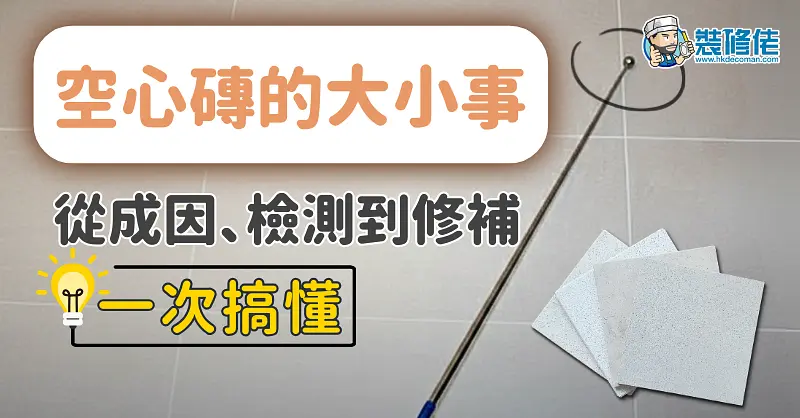Hollow Tiles: Causes, Risks, and Repair
Listen to the blog audio:

Tiles with hollow spots, commonly known as "hollow tiles," are a quite common quality issue in home renovation. Whether it's a new building inspection or an old home refurbishment, if you lightly tap the wall or floor and hear a hollow "thud" sound, it may indicate the presence of hollow tiles. This problem not only affects the appearance but can also pose safety hazards. Wait for Renovation Expert to explain the causes and potential consequences of hollow tiles in a simple and clear way, and provide practical detection and repair methods to help you create a safe and durable home environment.
What is "Hollow Tile"?
"Hollow tile" or "tile hollowing", refers to when tiles are laid, their backs do not fully adhere to the underlying cement structural layer, creating gaps. During inspection, we can use a hard object (such as a coin or a specialized tapping rod) to lightly tap the tile. If the sound is solid, it indicates good adhesion; if the sound is crisp and hollow, it suggests that hollowing may be present in that area.

The Four Major Causes of Hollow Tiles
The formation of hollow tiles is often not due to a single cause, but rather the combined result of material, construction, and environmental factors.
1. Inconsistent Construction Quality
- The workmanship of the installer is a decisive factor. Common mistakes include: insufficient or uneven application of adhesives (such as cement or tile adhesive); failure to fully compact with a rubber hammer after laying tiles, which traps air; or not properly treating tiles according to their water absorption characteristics (e.g., soaking in water) before installation.
2. Improper Base Preparation
- If the base for tiling (wall or floor) is not handled properly, it directly affects the bonding effect. For example: an uneven base, presence of dust or oil stains, or excessive dryness (which can rapidly absorb moisture from the adhesive) can all hinder the firm adhesion of tiles.
3. Choice of Material Quality
- The principle of "you get what you pay for" applies here as well. Poor-quality tiles may have unstable dimensions and water absorption rates. More importantly, the choice of adhesive is crucial. Compared to traditional cement, using high-quality tile adhesive is an effective method to prevent hollowing.
4. Building and Environmental Factors
- The condition of the building itself can also have an impact. For example, if a new building's structure hasn't fully settled and stabilized, or if there are water seepage issues on the exterior walls, it could cause ceramic tiles to become hollow from the inside.

Hollow Tile Potential Risks
Hollow tiles are not only unpleasant to hear; if left untreated, they can lead to a series of problems:
1. Safety Hazards: Hollow tiles have a fragile structure and are prone to cracking under heavy impact. More importantly, during sudden temperature changes (such as cold snaps), the physical effects of thermal expansion and contraction can cause tiles to bulge, crack, or even detach from the wall entirely, posing a threat to occupants.
2. Water Seepage and Mold: In damp areas like bathrooms and kitchens, moisture can seep into the hollow gaps through tile joints. Accumulated water is difficult to evaporate, and over time, it can breed mold, affecting hygiene and potentially damaging the underlying waterproofing.
3. Impact on Durability: Hollow tiles are unstable, which shortens their lifespan. Over the long term, they may become loose or have edges that curl up, affecting the home's aesthetics and daily cleaning.

Hollow Tile Inspection and Acceptable Standards
Homeowners can perform a simple "tap test" themselves, but how to determine the severity?
• Inspection Method: Use a hard object like a coin or screwdriver handle to gently tap the tile at its center and four corners. By listening for differences in sound, you can identify hollow spots. It's important to note that if the entire wall sounds hollow when tapped, it might be due to the wall itself being constructed with lightweight partition materials, and may not necessarily be a hollow tile issue.
• International Reference Standards: Although Hong Kong does not have a unified statutory standard, internationally it is generally accepted that minor hollowness is acceptable.
- American Standard (ANSI): For general indoor tile installations, the hollow area should not exceed 20% of the total area (meaning the contact area reaches 80%). For wet areas like bathrooms, the requirement is stricter, requiring a contact area of 95%.
- Australian Standard (AS): If the hollow area of a single tile exceeds 20% of its total area, it should be considered a long-term risk.

Methods for Repairing Hollow Tiles
If hollow tiles are discovered, you can choose from the following two repair methods based on their location and severity:
1. Grout Injection Repair
- This method is suitable when the hollow area is at the edge of the tile and the condition is not yet severe. The craftsman will carefully cut open the grout in the tile joints, then use pressure grouting to inject specially formulated cement grout or epoxy resin grout into the hollow space to fill it. The advantage is that there is no need to remove the tiles, minimizing damage to the surface of the tile.
2. Removal and Reinstallation
- If the hollow area is in the center of the tile, the affected area is too large, or the tile has already bulged, the most thorough method is to remove the problematic tile, clean the base layer, and then reinstall it. This is the best solution to根治問題 (address the root cause). For this reason, it is recommended to purchase a few extra tiles during renovation as backups for future repairs.
If you want to learn more about renovation knowledge, feel free to contact the Renovation Academy.
【Book Home Clinic Service Immediately】
【Editor's Picks】
From renovation quotes to pre- and post-move-in, comprehensive one-stop support!
>> Get free renovation quote: https://hkdecoman.com/measure
>> Book a Home Clinic (Inspection/Cleaning/Maintenance): https://clinic.deco-x.com/
Specialized Sections by Property Type:
>> Public Housing https://decoman-publichousing.com/
>> Private Housing https://decoman-privatehousing.com/
>> New Developments https://decoman-newproperties.com/
>> Tangyang Building https://decoman-tenement.com/
================================================================
*** This article is republished with permission from Renovation Man ***
